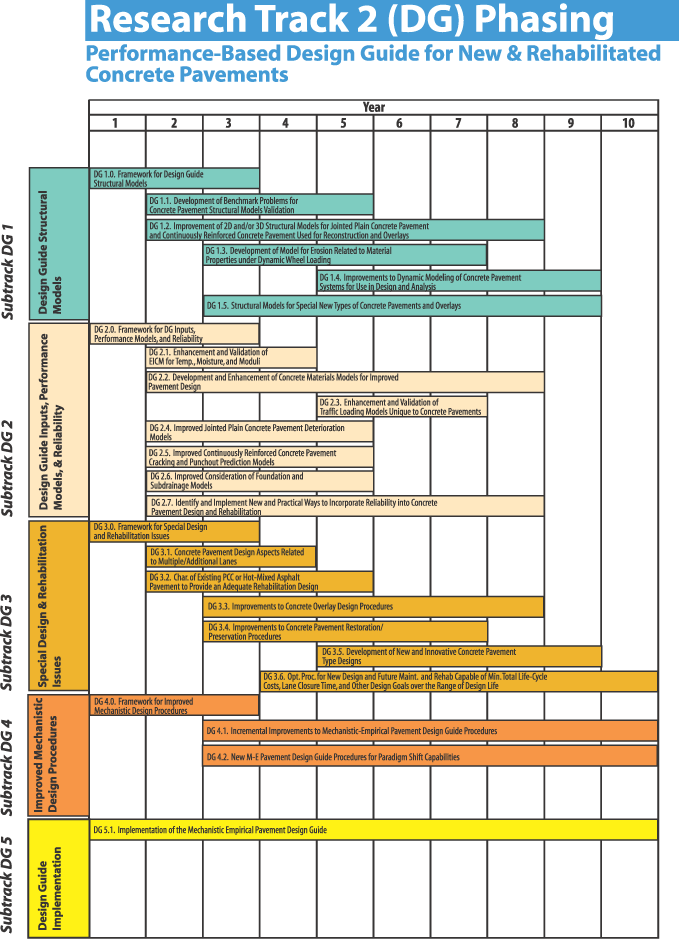U.S. Department of Transportation
Federal Highway Administration
1200 New Jersey Avenue, SE
Washington, DC 20590
202-366-4000
Federal Highway Administration Research and Technology
Coordinating, Developing, and Delivering Highway Transportation Innovations
 |
| This report is an archived publication and may contain dated technical, contact, and link information |
|
Publication Number: FHWA-HRT-05-053 Date: September 2005 |

Figure 2. Track 2 (DG) subtrack and problem statement phasing chart.
Track 2 (DG) subtrack and problem statement phasing chart.The horizontal bar chart in this figure shows the approximate time phasing of the problem statements in track 2, Performance-Based Design Guide for New and Rehabilitated Concrete Pavements (DG) grouped by subtrack across 10 years. There are five subtracks in track 2: (1) Design Guide Structural Models; (2) Design Guide Inputs, Performance Models, and Reliability; (3) Special Design and Rehabilitation Issues; (4) Improved Mechanistic Design Procedures; and (5) Design Guide Implementation
In subtrack 1, the problem statements are arranged as follows: Problem Statement DG 1.0. Framework for Design Guide Structural Models extends from years 1 to 3; Problem Statement DG 1.1. Development of Benchmark Problems for Concrete Pavement Structural Models Validation extends from years 2 to 5; Problem Statement DG 1.2. Improvement of 2D and/or 3D Structural Models for Jointed Plain Concrete Pavement and Continuously Reinforced Concrete Pavement Used for Reconstruction and Overlays extends from years 2 to 8; Problem Statement DG 1.3. Development of Model for Erosion Related to Material Properties under Dynamic Wheel Loading extends from years 3 to 7; Problem Statement DG 1.4. Improvements to Dynamic Modeling of Concrete Pavement Systems for Use in Design and Analysis extends from years 5 to 9; and Problem Statement DG 1.5. Structural Models for Special New Types of Concrete Pavements and Overlays extends from years 3 to 9.
In subtrack 2, the problem statements are arranged as follows: Problem Statement DG 2.0. Framework for Design Guide Inputs, Performance Models, and Reliability extends from years 1 to 3; Problem Statement DG 2.1. Enhancement and Validation of Enhanced Integrated Climatic Models for Temperature, Moisture, and Moduli extends from years 2 to 4; Problem Statement DG 2.2. Development and Enhancement of Concrete Materials Models for Improved Pavement Design extends from years 2 to 8; Problem Statement DG 2.3. Enhancement and Validation of Traffic Loading Models Unique to Concrete Pavements extends from years 5 to 7; Problem Statement DG 2.4. Improved Jointed Plain Concrete Pavement Deterioration Models extends from years 2 to 5; Problem Statement DG 2.5. Improved Continuously Reinforced Concrete Pavement Cracking and Punchout Prediction Models extends from years 2 to 5; Problem Statement DG 2.6. Improved Consideration of Foundation and Subdrainage Models extends from years 2 to 5; and Problem Statement DG 2.7. Identify and Implement New and Practical Ways to Incorporate Reliability into Concrete Pavement Design and Rehabilitation extends from years 2 to 8.
In subtrack 3 the problem statements are arranged as follows: Problem Statement DG 3.0. Framework for Special Design and Rehabilitation Issues extends from years 1 to 3; Problem Statement DG 3.1. Concrete Pavement Design Aspects Related to Multiple/Additional Lanes extends from years 2 to 4; Problem Statement DG 3.2. Characterization of Existing PCC or Hot-Mix Asphalt Pavement to Provide an Adequate Rehabilitation Design extends from years 2 to 5; Problem Statement DG 3.3. Improvements to Concrete Overlay Design Procedures extends from years 3 to 8; Problem Statement DG 3.4. Improvements to Concrete Pavement Restoration/Preservation Procedures extends from years 3 to 7; Problem Statement DG 3.5. Development of New and Innovative Concrete Pavement Type Designs extends from years 5 to 9; and Problem Statement DG 3.6. Optimizing Procedure for New Design and Future Maintenance and Rehabilitation Capable of Minimizing Total Life Cycle Costs, Lane Closure Time, and Other Design Goals over the Range of Design Life extends from years 4 to 10.
In subtrack 4 the problem statements are arranged as follows: Problem Statement DG 4.0. Framework for Improved Mechanistic Design Procedures extends from years 1 to 3; Problem Statement DG 4.1. Incremental Improvements to Mechanistic-Empirical Pavement Design Guide Procedures extends from years 3 to 10; and Problem Statement DG 4.2. New Mechanistic-Empirical Pavement Design Guide Procedures for Paradigm Shift Capabilities extends from years 3 to 10.
Subtrack 5 contains only one problem statement: Problem Statement DG 5.1. Implementation of the Mechanistic-Empirical Pavement Design Guide extends from years 1 to 10.